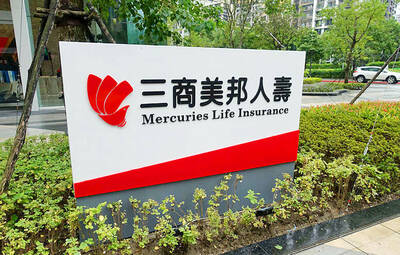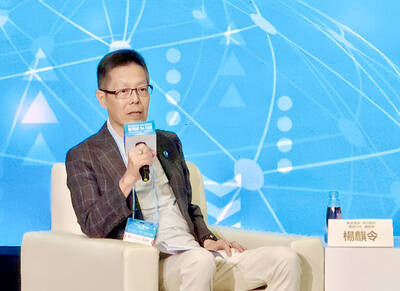Gigabyte Technology Co (技嘉) yesterday said that strong sales of its consumer electronics-related products, such as motherboards and graphics cards, would continue this quarter, and that demand remains strong for its server products — artificial intelligence (AI) servers in particular.
Overall, the company is confident that revenue growth would remain steady this quarter. It expects this year’s revenue to exceed NT$100 billion (US$3.08 billion) earlier than expected, thanks to continued end-market demand and effective optimization of its product mix, it said in a presentation document released after the company’s online investors’ conference.
Gigabyte’s revenue last quarter was NT$36.9 billion, up 52.53 percent year-on-year and 41.2 percent quarter-on-quarter.

Photo: Ann Wang, Reuters
It was the highest quarterly figure in the company’s history, the company said.
Sales from graphics cards accounted for 36 percent of Gigabyte’s total sales in the third quarter, followed by servers at 27 percent, motherboards at 22 percent, and laptops and other computer peripherals at 15 percent, it said.
The company’s graphics card business has come out of the trough experienced in the first half of the year, with demand recovering and shipments booming in the second half as clients stepped up efforts to reduce channel inventories, Gigabyte told investors.
Its motherboard business is expected to return to positive sales growth next year following clear signs of improvement in the bottom half of this year, while server shipments are likely to register a high double-digit percentage increase this year, as demand for AI services continues to rise, it said.
To meet demand from clients, the company plans to optimize the production capacity of two server assembly plants in Taiwan, Gigabyte said, adding that its main customers are in Europe and the US, but it aims to gain orders from the Asia-Pacific region.
The US AI chip ban would not affect Gigabyte as it is not shipping to China, it said.
Gigabyte is striving to maintain its leadership by providing a wider choice of product lines compared with its local peers, it said.
While it remains a strong supply partner of US graphics chip designer Nvidia Corp, it aims to launch new server products for other chipmakers and cloud service providers next year, Gigabyte said.
The company did not reveal its bottom-line figures for the third quarter, but analysts forecast that its gross margin would improve to 13.3 percent from 11.83 percent in the second quarter, while its earnings per share would grow to NT$2.72 from NT$1.4, given better economies of scale and higher-than-expected sales in the third quarter.
Gigabyte’s cumulative sales in the first nine months of the year totaled NT$91.37 billion, an increase of 15.13 percent from the same period of last year and a record high for the period, the company said.
By region, American markets contributed 41 percent to the company’s sales, followed by the Asia-Pacific region with 34 percent and Europe and the Middle East with 25 percent, it said.
Editor's note - Gigabyte on Nov. 3 reported net profit of NT$1.48 billion in the third quarter, up 66.43 percent quarter-on-quarter and 26.63 percent year-on-year. Earnings per share were NT$2.33, the highest in the past six quarters. Gross margin was 13.27 percent, the highest in five quarters, and operating margin reached 3.02 percent.

Mercuries Life Insurance Co (三商美邦人壽) shares surged to a seven-month high this week after local media reported that E.Sun Financial Holding Co (玉山金控) had outbid CTBC Financial Holding Co (中信金控) in the financially strained insurer’s ongoing sale process. Shares of the mid-sized life insurer climbed 5.8 percent this week to NT$6.72, extending a nearly 18 percent rally over the past month, as investors bet on the likelihood of an impending takeover. The final round of bidding closed on Thursday, marking a critical step in the 32-year-old insurer’s search for a buyer after years of struggling to meet capital adequacy requirements. Local media reports

US sports leagues rushed to get in on the multi-billion US dollar bonanza of legalized betting, but the arrest of an National Basketball Association (NBA) coach and player in two sprawling US federal investigations show the potential cost of partnering with the gambling industry. Portland Trail Blazers coach Chauncey Billups, a former Detroit Pistons star and an NBA Hall of Famer, was arrested for his alleged role in rigged illegal poker games that prosecutors say were tied to Mafia crime families. Miami Heat guard Terry Rozier was charged with manipulating his play for the benefit of bettors and former NBA player and

TECHNOLOGICAL RIVALRY: The artificial intelligence chip competition among multiple players would likely intensify over the next two years, a Quanta official said Quanta Computer Inc (廣達), which makes servers and laptops on a contract basis, yesterday said its shipments of artificial intelligence (AI) servers powered by Nvidia Corp’s GB300 chips have increased steadily since last month, should surpass those of the GB200 models this quarter. The production of GB300 servers has gone much more smoothly than that of the GB200, with shipments projected to increase sharply next month, Quanta executive vice president Mike Yang (楊麒令) said on the sidelines of a technology forum in Taipei. While orders for GB200 servers gradually decrease, the production transition between the two server models has been

BETTER THAN EXPECTED: The firm’s Q3 results exceeded its projections, based on ‘the underlying strength of our core markets,’ chief financial officer Dave Zinsner said Intel Corp returned to profitability and gave an upbeat revenue forecast after PC demand grew, suggesting that it is making progress on a long and challenging comeback attempt. In the third quarter, revenue rose 3 percent to US$13.7 billion. The Santa Clara, California-based company posted its first quarterly net income since the end of 2023, with earnings per share of US$0.23, excluding some items. Analysts had estimated sales of US$13.2 billion and earnings per share of US$0.01 on average, according to data compiled by Bloomberg. Fourth-quarter sales would be roughly US$13.3 billion, the company said in a statement on Thursday. Intel shares gained about